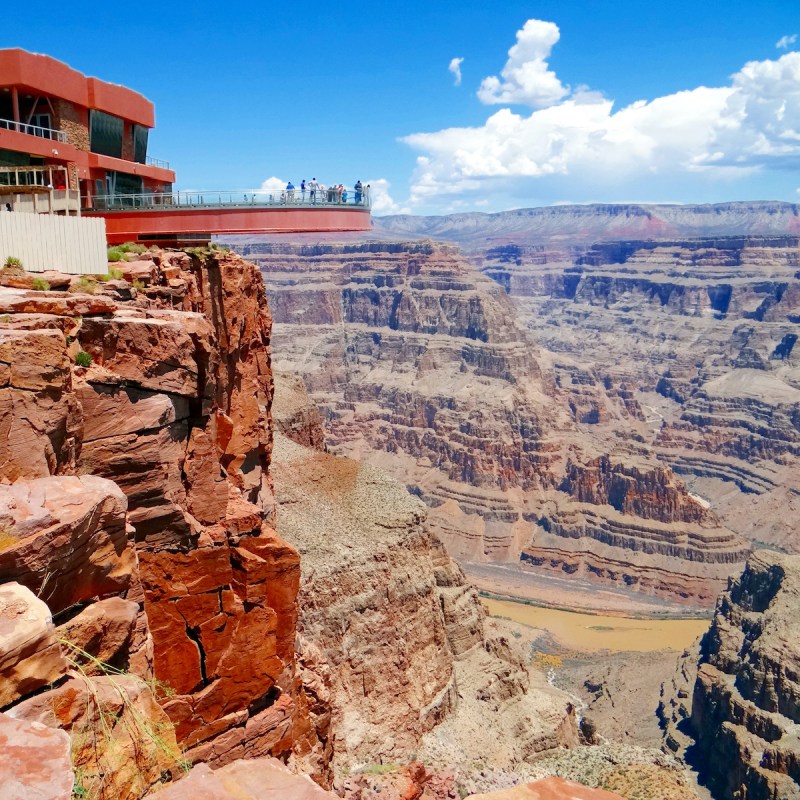
From giant saguaro cacti to the deep Grand Canyon, Arizona is full of natural wonders and beauty that can’t be experienced anywhere else in the United States. Add a shout-out to a popular Eagles song, the vision of a world-renowned architect, a massive ecological experiment, and more, and you have these 11 unique spots that can only be experienced in Arizona.
Videos by TravelAwaits
My favorite time to visit the Grand Canyon State is the spring, when wildflowers paint the mountain meadows and desert floors with color. But you can visit these unique spots in Arizona at any time of the year. While the destinations within a many-mile radius of Phoenix provide a sunny respite from frigid winters elsewhere in the U.S., they can be quite unbearable in the summer. In fact, Phoenix and Tucson are the hottest cities in the U.S., with more than 140 days a year topping 90 degrees. So June, July, and August are fantastic months to visit Northern Arizona instead.
This list of unique spots starts with the Grand Canyon, one of the most-visited destinations in the state, and moves clockwise.
1. Grand Canyon National Park, Northwestern Arizona
Colorado’s capital city may be a mile above sea level, but in Arizona, visitors gaze into a wide crevice that is a mile deep. And at 277 miles long and 18 miles wide, the natural wonder of the world that inspired Arizona’s state nickname covers more square miles than Rhode Island. The panoramic views of the striped limestone walls carved by the Colorado River attract nearly six million visitors a year, making Grand Canyon National Park one of the most visited in the park system.
Pro Tip: Plan an amazing trip to the Grand Canyon with these articles.
2. Grand Canyon Skywalk, Peach Springs
While there’s hardly a bad view anywhere along the rim of the Grand Canyon, adrenaline junkies and acrophiles will definitely want to stroll 70 feet out above the canyon along the horseshoe-shaped, glass-bottomed Skywalk west of the national park on the Hualapai Reservation. And if you’re brave enough to do so, you will be treated to unique views from 4,000 feet above the canyon floor.

3. Meteor Crater Natural Landmark, Coconino County
While it’s not as wide or deep as the Grand Canyon, the Barringer Meteor Crater near Flagstaff is the nation’s largest-known impact crater (and Arizona’s second-most-famous hole in the ground). Although it has been designated a natural landmark, the land where a massive meteorite crashed to Earth approximately 50,000 years ago remains privately owned by the Barringer family and is not maintained by the National Park Service. Learn more about the 550-foot-deep, 4,000-foot-wide crater through a brief film, museum exhibits, and a guided rim tour.

4. Standin’ On The Corner Park, Winslow
When many midlife travelers hear the words “Winslow, Arizona,” they immediately think of the Eagles song Take It Easy, in which a girl in a flatbed Ford slows down to take a look at the singer. And now the lyrics penned when Jackson Browne’s car broke down in the small Arizona town have been immortalized at the corner of Route 66 and North Kinsley Avenue. Only in Arizona can you stop by Standin’ on the Corner Park and snap a selfie with a guitar-wielding statue in front of a muraled backdrop featuring a young blonde woman behind the wheel of a red Ford truck.

5. Petrified Forest National Park, Holbrook
Traveling east from Winslow, the historic Route 66 — or the newer Interstate 40 — will take you to Petrified Forest National Park. It’s the only national park site that includes a segment of the Mother Road that once connected Chicago to Santa Monica. In addition to a one-of-a-kind experience along Route 66 in Arizona, you’ll also be treated to some spectacular scenery, especially if you think forests are deep green and deserts are boring brown!
Covering more than 220,000 acres in Northeastern Arizona, Petrified Forest National Park protects one of the largest concentrations of petrified wood in the world. Over millions of years, nature transformed the fallen trees in this prehistoric forest into colorful works of art. Today, the woody colors you’d expect to see when gazing at a fallen log have been replaced with sparkling white, brilliant blue, deep red, and other colors thanks to quartz, manganese oxides, and iron oxides.
Pro Tip: When you visit Petrified Forest, be sure to also explore the Painted Desert in the northwestern corner of the park.

6. Taliesin West, Scottsdale
You might associate legendary architect Frank Lloyd Wright with the original Taliesin, an 800-acre estate in Southwestern Wisconsin. But in his 70s, Wright was as fed up with winter as any other Midwesterner (including me) and migrated west to Scottsdale. Now a UNESCO World Heritage site and National Historic Landmark, the sand and stone structures with abundant natural light and long, horizontal lines at Taliesin West are proof that Wright remained inspired by nature until his death in 1959.

7. Biosphere 2, Oracle
In the 1990s, eight scientists made international news when they were voluntarily sealed inside a massive glass enclosure for two years. Known as Biosphere 2 (because Earth is the original biosphere), the 3-acre site about an hour north of Tucson was used to gain a deeper understanding of the complexity of our planet and the relationship between plants, animals, and elements. Touring this fascinating structure is something you can only do in Arizona.
Fun Fact: Biosphere 2 was parodied in the 1996 movie Bio-Dome starring Pauly Shore and Stephen Baldwin.

8. Saguaro National Park, Tucson
Native to the Sonoran Desert, the majestic saguaro cactus found in Southern Arizona is as synonymous with Arizona as the Grand Canyon. One of the most impressive places to see these multibranched, prickly giants is Saguaro National Park, where hundreds of cacti dot the craggy foothills north of Tucson. Visit around sunrise or sunset at any time of year for the most spectacular views. If you’re lucky enough to visit on an infrequent rainy day, be sure to breathe in the unique scent of desert rain caused by damp creosote bushes. And if you visit Tucson between late April and early June, keep an eye out for another rare sight: saguaro cactus flowers. These beauties — the Arizona state flower — only bloom for 24 hours.

9. Mi Nidito, Tucson
Whether entertaining a foreign leader at a state dinner or dining in the residence on a Tuesday night, I envision the president of the U.S. eating like a king. And when he dines out, I expect him to visit some of the best restaurants in the country. That’s what makes this next spot in Arizona so unique. Inside an unassuming, brightly painted adobe building on Fourth Avenue in Tucson, Mi Nidito has welcomed rock stars, Hollywood elite, sports legends, and heads of state. In fact, the President’s Plate — a bean tostada, birria taco, chile relleno, chicken enchilada, and beef tamale — was created in recognition of President Bill Clinton’s visit in February of 1999. And, you guessed it — the rectangular six-top marked with a gold star and rimmed with photos of the POTUS 42 is where Clinton enjoyed some of the best Mexican food in the Southwest.

10. Davis-Monthan Air Force Base Aircraft Boneyard, Tucson
Have you ever wondered what happens to an airplane when it is decommissioned? Like many midlife humans, commercial airplanes and fighter jets retire in the American Southwest. Known as boneyards, there are seven major destinations for permanently grounded aircraft in Arizona, California, and New Mexico. But the largest boneyard in the world is the Aerospace Maintenance and Regeneration Group (AMARG) at Davis-Monthan Air Force Base, where 4,400 jets are parked on 2,600 acres near Tucson. Because AMARG is a controlled-access facility, the only way to visit this boneyard is via a tour from the Pima Air & Space Museum.

11. Titan Missile Museum, Green Valley
When I was a teenager attending school on a NATO base in Europe in the 1980s, the Cold War was very real. While my fellow Americans stateside watched Red Dawn and Spies Like Us on the big screen, the AWACS that regularly glided past my classroom window made me fearful that the next world war could erupt in Europe between the U.S. and the USSR at any time. Visiting the Titan Missile Museum and exploring the last of the 54 Titan II missile sites that were on alert across the country from 1963 to 1987 is a one-of-a-kind experience only possible in Arizona and a great way to bring closure to the fear many people around the world felt during the Cold War.
Pro Tip: To descend 35 feet into the missile complex, see the control center, and experience a simulated launch of the Titan Missile, you’ll need to be able to go down 55 steps and climb back up them at the end of your visit.
From natural wonders to man-made marvels, these 11 unique spots are must-see attractions in Arizona.
